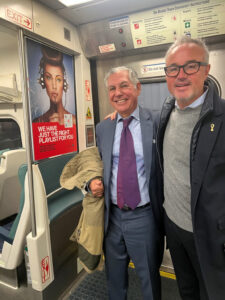Federico Scialabba: Publishing, managing, and adapting are visible and invisible tasks within the professional ecosystem.

In March 2025, a working session took place in Madrid as part of YouTube’s Global Convention, bringing together five professionals connected to the handling of music catalogs on digital platforms. The participants held roles in technical, commercial, and operational areas: Dan Chalmers, Tasha Taylor, Paul Smith, Federico Scialabba, and Charlie Sánchez.
Although the session was not open to the public, the convergence of these figures offers insight into the current distribution of responsibilities in the online music content system. Platforms like YouTube Music do not operate autonomously; they rely on prior processes, internal reviews, specific agreements, and real-time troubleshooting. For content to be available to users, multiple steps must be completed behind the scenes.
What Is YouTube Music and How Does It Work?
YouTube Music is Google’s music streaming service. It integrates official audio files, live recordings, recent releases, and user-generated audiovisual content. Unlike other platforms, it doesn’t rely solely on conventional discographies. Its system includes user uploads and alternative versions that must be analyzed, cataloged, and monetized where applicable. The service is available in over 90 countries. Its operation requires licensing agreements and regional adaptations, as each country has its own laws. This forces the platform to constantly review availability conditions, formats, rights transfers, fees, and local practices.
Platform Operations and Work Areas
Dan Chalmers oversees YouTube’s music teams across Europe, the Middle East, and Africa (EMEA). His role includes developing regional partnerships and managing the overall relationship between the platform and content operators. Tasha Taylor, also working in the EMEA region, handles direct relationships with catalog managers—particularly labels and distributors who upload their material. Her focus is on solving technical needs and ensuring content compatibility with YouTube’s internal systems.
Paul Smith, based in the Asia-Pacific region, operates within a diverse legal and commercial landscape. His responsibility includes reviewing workflows in countries where the publishing and commercial use of content require local authorizations or technical adjustments to comply with regulations.
Direct Catalog Management by Independent Labels
Another important area is represented by those who publish content without intermediaries. Federico Scialabba (Music Brokers) and Charlie Sánchez (Metales Preciosos Música & Discos) lead independent labels that manage every stage of their catalogs: selection, processing, licensing, and conflict resolution regarding rights or content matches.
Music Brokers has been producing and distributing content since the late 1990s, working with licensed material, original developments, and an international catalog. The company publishes its content on digital platforms through internal administration.
Metales Preciosos, based in Spain, operates as an independent label with its own publishing criteria. Both labels are responsible for uploading, updating, and correcting their materials directly, which includes handling technical data, reviewing match reports, and maintaining catalog order.






